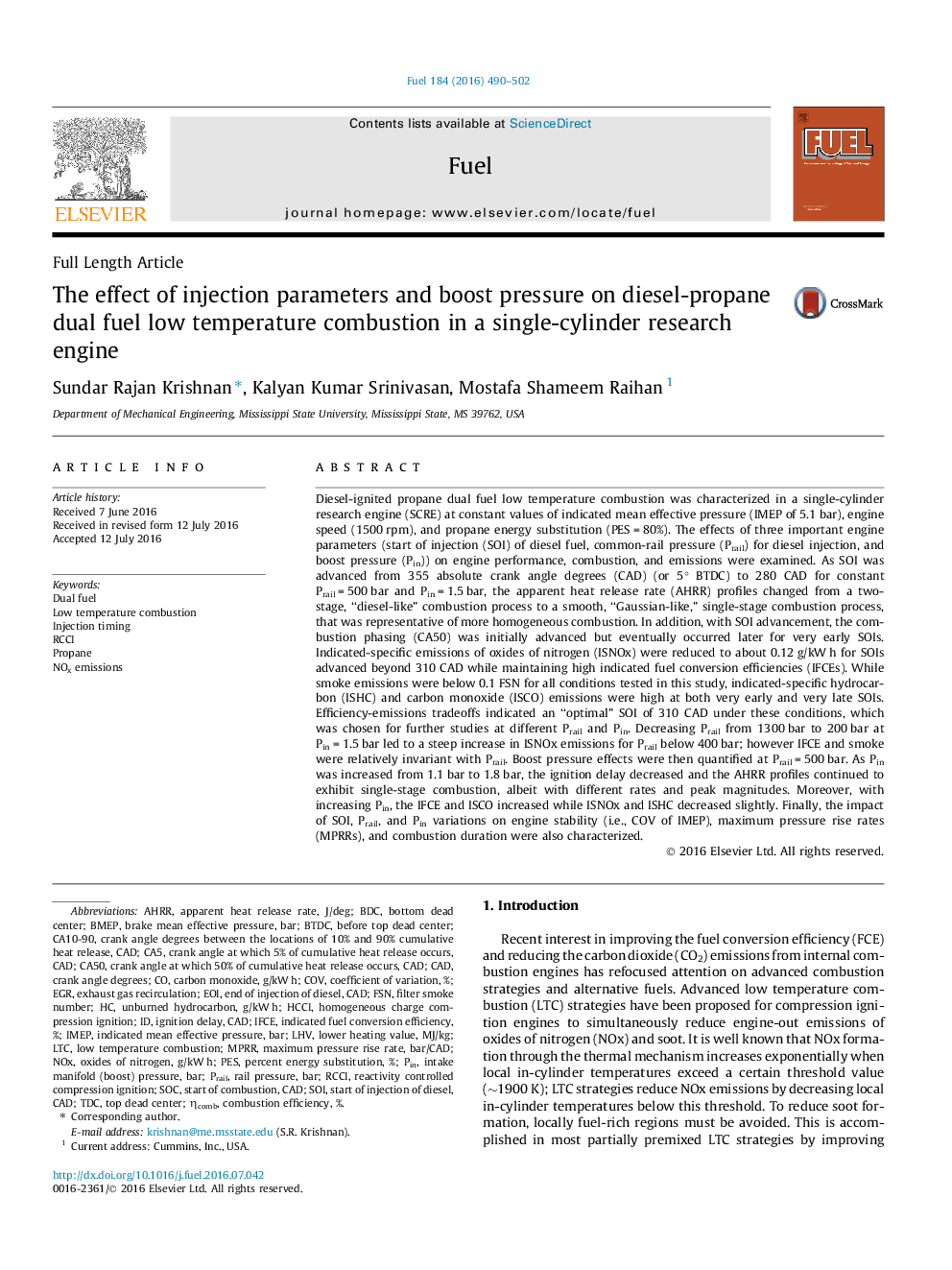| کد مقاله | کد نشریه | سال انتشار | مقاله انگلیسی | نسخه تمام متن |
|---|---|---|---|---|
| 6633056 | 461089 | 2016 | 13 صفحه PDF | دانلود رایگان |
عنوان انگلیسی مقاله ISI
The effect of injection parameters and boost pressure on diesel-propane dual fuel low temperature combustion in a single-cylinder research engine
ترجمه فارسی عنوان
اثر پارامترهای تزریق و افزایش فشار بر سوخت دیزل - پروپان سوخت دوگانه سوخت در یک موتور تحقیقاتی تک سیلندر
دانلود مقاله + سفارش ترجمه
دانلود مقاله ISI انگلیسی
رایگان برای ایرانیان
کلمات کلیدی
IMEPCA10-90CA50AHRRLHVBMEPRCCILTCSOIMPRRCA5HCCIPESTDCEOIBDCFSNEGRbTDC - BTDCNOx - NOXReactivity controlled compression ignition - Reactivity کنترل جرقه فشرده سازیCOV - THELow temperature combustion - احتراق دما پایینNOx emissions - انتشار NOxCrank angle degrees - درجه زاویه لبهDual fuel - دوگانهسوزInjection timing - زمان تزریقHomogeneous Charge Compression Ignition - سوپاپ فشرده سازی همگنSOC - سیستم روی یک تراشهFilter Smoke Number - شماره دود فیلترCAD - طراحی به کمک رایانه یا کَدbefore top dead center - قبل از مرده مردهtop dead center - مرکز مرده بالاBottom Dead Center - مرکز مرده پایینPropane - پروپانPIN - پینexhaust gas recirculation - گردش بازگشتی گاز اگزوز
موضوعات مرتبط
مهندسی و علوم پایه
مهندسی شیمی
مهندسی شیمی (عمومی)
چکیده انگلیسی
Diesel-ignited propane dual fuel low temperature combustion was characterized in a single-cylinder research engine (SCRE) at constant values of indicated mean effective pressure (IMEP of 5.1 bar), engine speed (1500 rpm), and propane energy substitution (PES = 80%). The effects of three important engine parameters (start of injection (SOI) of diesel fuel, common-rail pressure (Prail) for diesel injection, and boost pressure (Pin)) on engine performance, combustion, and emissions were examined. As SOI was advanced from 355 absolute crank angle degrees (CAD) (or 5° BTDC) to 280 CAD for constant Prail = 500 bar and Pin = 1.5 bar, the apparent heat release rate (AHRR) profiles changed from a two-stage, “diesel-like” combustion process to a smooth, “Gaussian-like,” single-stage combustion process, that was representative of more homogeneous combustion. In addition, with SOI advancement, the combustion phasing (CA50) was initially advanced but eventually occurred later for very early SOIs. Indicated-specific emissions of oxides of nitrogen (ISNOx) were reduced to about 0.12 g/kW h for SOIs advanced beyond 310 CAD while maintaining high indicated fuel conversion efficiencies (IFCEs). While smoke emissions were below 0.1 FSN for all conditions tested in this study, indicated-specific hydrocarbon (ISHC) and carbon monoxide (ISCO) emissions were high at both very early and very late SOIs. Efficiency-emissions tradeoffs indicated an “optimal” SOI of 310 CAD under these conditions, which was chosen for further studies at different Prail and Pin. Decreasing Prail from 1300 bar to 200 bar at Pin = 1.5 bar led to a steep increase in ISNOx emissions for Prail below 400 bar; however IFCE and smoke were relatively invariant with Prail. Boost pressure effects were then quantified at Prail = 500 bar. As Pin was increased from 1.1 bar to 1.8 bar, the ignition delay decreased and the AHRR profiles continued to exhibit single-stage combustion, albeit with different rates and peak magnitudes. Moreover, with increasing Pin, the IFCE and ISCO increased while ISNOx and ISHC decreased slightly. Finally, the impact of SOI, Prail, and Pin variations on engine stability (i.e., COV of IMEP), maximum pressure rise rates (MPRRs), and combustion duration were also characterized.
ناشر
Database: Elsevier - ScienceDirect (ساینس دایرکت)
Journal: Fuel - Volume 184, 15 November 2016, Pages 490-502
Journal: Fuel - Volume 184, 15 November 2016, Pages 490-502
نویسندگان
Sundar Rajan Krishnan, Kalyan Kumar Srinivasan, Mostafa Shameem Raihan,
